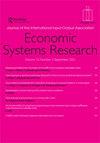构建SAMEA以分析智利的能源和环境政策
IF 1.8
4区 经济学
Q2 ECONOMICS
引用次数: 6
摘要
在本研究中,基于2016年投入产出表、社会经济家庭调查、支出调查等信息来源,建立了智利的社会核算与环境核算矩阵(SAMEA)。SAMEA对电力部门的分类很高,而目前国民账户中没有。从国家和国际研究中获得了关于不同电力子部门(热电、太阳能、风能、水力和生物质)运营成本的补充信息。然后,计算部门间指标、会计乘数和冲击模拟(非传统可再生能源部门补贴和环境税)。研究的主要发现表明,每个电力部门都有不同的生产技术和排放强度。因此,用部门间模型模拟的能源和环境政策,如果没有对电力部门进行分解,结果会产生重大偏差。本文章由计算机程序翻译,如有差异,请以英文原文为准。
Constructing a SAMEA to analyze energy and environmental policies in Chile
In this study, a social accounting matrix with environmental accounts (SAMEA) for Chile is built based on the 2016 input-output tables, socioeconomic household survey, expenditure survey, among other information sources. The SAMEA has high disaggregation of the electricity sector that is not currently available in national accounts. Complementary information on the operating costs of different electricity subsectors (thermoelectric, solar, wind, hydro, and biomass) from national and international studies are obtained. Then, intersectoral indicators, accounting multipliers, and simulations of shocks (subsidy on the non-conventional renewable energy subsectors and environmental taxes) are calculated. The main findings of the study show that each electricity subsector has different production technology and emission intensity. In consequence, energy and environmental policies simulated with intersectoral models that do not disaggregate the electricity sector would produce significant biases in the results.
求助全文
通过发布文献求助,成功后即可免费获取论文全文。
去求助
来源期刊

Economic Systems Research
ECONOMICS-
CiteScore
5.60
自引率
4.00%
发文量
17
期刊介绍:
Economic Systems Research is a double blind peer-reviewed scientific journal dedicated to the furtherance of theoretical and factual knowledge about economic systems, structures and processes, and their change through time and space, at the subnational, national and international level. The journal contains sensible, matter-of-fact tools and data for modelling, policy analysis, planning and decision making in large economic environments. It promotes understanding in economic thinking and between theoretical schools of East and West, North and South.
 求助内容:
求助内容: 应助结果提醒方式:
应助结果提醒方式:


